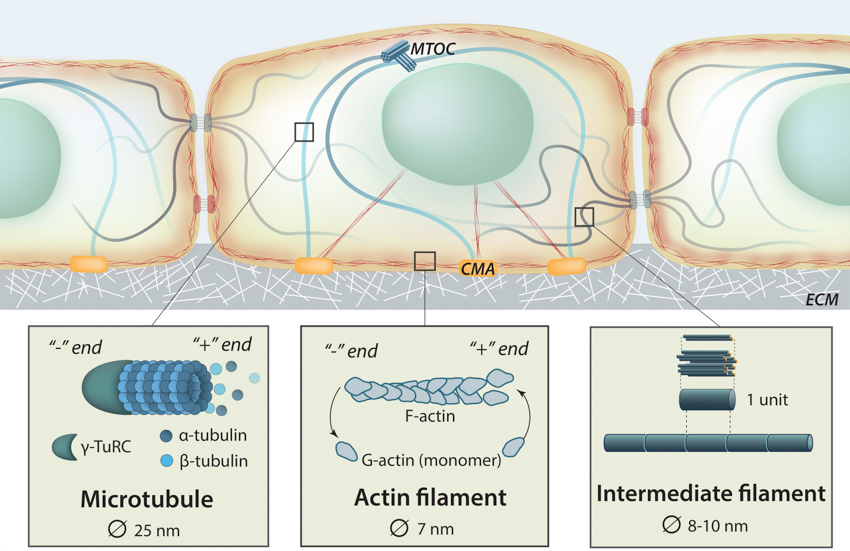What is the Cytoskeleton?
The eukaryotic cytoskeleton is a network of three long filament systems, made from the repetitive assembly and disassembly of dynamic protein components. The primary filament systems comprising the cytoskeleton are microtubules, actin filaments, and intermediate filaments. It creates an internal architecture (see figure below) to give a cell its shape through elaborate linkage(s) to itself, the plasma membrane, and internal organelles.

Three main components of the cytoskeleton include actin filaments (also called microfilaments), microtubules and intermediate filaments. They are distinct structural compositions that exhibit slightly different yet interdependent functions.
The cytoskeleton structure is modified by adhesion to neighboring cells or to the extracellular matrix (ECM). The strength and the type of these adhesions are pivotal for regulating the assembly/disassembly of the cytoskeleton components. This dynamic property enables cellular movement, which is governed by forces (both internal and external). This information is sensed by mechanosensors and disseminated via the cytoskeleton leading to chemical signalling and response.
Although subunits of all three filament systems are present throughout the cell, differences in the subunit structures and the attractive forces between them impart each system with variable stabilities and distinct mechanical properties. These characteristics explain their distribution in particular structures and/or regions of the cell. Numerous cytoskeletal-associated proteins also help to regulate the spatial and temporal distribution of the cytoskeleton. The organization and assembly of one filament system is influenced by the others in a coordinated fashion for most cellular functions.
Accessory proteins organize filaments into higher-order structures
Crosslinking of the filaments by specific motors or multivalent binding proteins (accessory proteins) increases stability and forms higher-order structures. Such organization facilitates generation of long-term contractile forces and occasionally support compressive forces while being dynamic. These structures are connected across cells through junctions and hence facilitate mechanotransduction and cumulative response at a tissue- or organ-level (see the lower panel in the figure below and “Mediators of mechanotransduction” for details on junctions).
Accessory proteins are a critical part of the signaling network that integrates extra- and intracellular signals (e.g. force, ions etc.) with the cytoskeleton assembly module(s). These can be specific for certain types of filaments. E.g., fimbrin binds only actin filaments, while others like plectin are non-specific.
Accessory factors can also help regulate the stability, mechanical properties, and force production for the individual filaments within the larger structure. For example, fascin crosslinks actin filaments into rigid bundles that have mechanical strength for generating protrusive force, while filamin cross links the actin filaments into gel-like networks that are flexible and produce less force. Examples of higher-order cytoskeleton structures:
Contractile bundles found in muscle cells: Composed of actin filaments and a number of accessory proteins – tropomyosin stabilizes actin filaments and regulates the association of myosin to control the timing of contraction.
The microtubule organizing center (MTOC) creates global organization of the microtubule network to establish the polarity and positioning of the cell organelles.
Nuclear lamina: Composed of intermediate filaments and the mitotic spindle (made of microtubules). Lamina are tensed mechanistically with the continuous network of chromosomes and nuclear matrix.
The intermediate filaments also form flexible cables from the cell surface to the center to form a ‘cage’ around the nucleus. These structures equipped with accessory proteins have extra resilience and toughness relative to individual filaments. E.g., filaggrin tightly bundles keratin filaments in the upper layer(s) of skin cells providing resistance to physical stress and water loss. Bacteria harbor similar proteins and filaments, however, the filament-associated proteins vary greatly between species and it is not currently known how they evolved from prokaryotes to eukaryotes.


